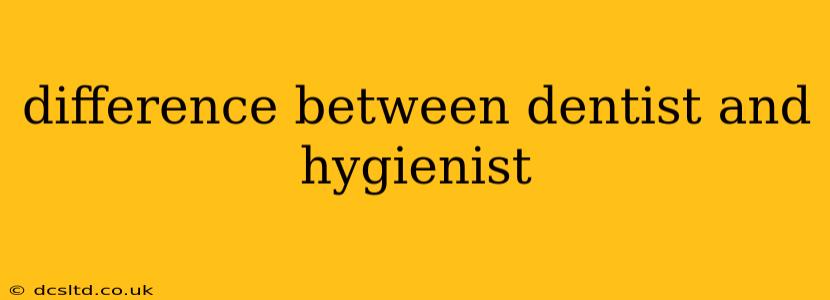The dental team is a collaborative group of professionals, each with specific roles and responsibilities. While both dentists and dental hygienists are crucial for maintaining oral health, their training, duties, and scope of practice differ significantly. Understanding these distinctions is vital for choosing the right professional for your needs and appreciating the contributions of each to your overall dental well-being.
What Does a Dentist Do?
Dentists are medical doctors specializing in the diagnosis, prevention, and treatment of diseases and conditions affecting the teeth, gums, and oral cavity. Their extensive training equips them to handle a wide range of procedures, including:
- Diagnosis and Treatment of Oral Diseases: Dentists diagnose and treat conditions like cavities, gum disease (periodontitis), oral cancer, and temporomandibular joint (TMJ) disorders.
- Restorative Dentistry: This includes filling cavities, placing crowns and bridges, and performing root canals to restore damaged teeth.
- Cosmetic Dentistry: Dentists offer cosmetic procedures like teeth whitening, veneers, and orthodontics (braces or Invisalign).
- Extractions: Removing teeth that are damaged or beyond repair.
- Implants: Placing dental implants, artificial tooth roots, to support replacement teeth.
- Oral Surgery: Performing minor oral surgeries such as biopsies and the removal of impacted wisdom teeth.
- Prescription Writing: Dentists can prescribe medication for pain, infections, and other oral health issues.
What Does a Dental Hygienist Do?
Dental hygienists are licensed professionals who work under the supervision of a dentist, focusing on preventive oral care. Their primary responsibilities include:
- Prophylaxis: This is the professional cleaning of teeth, removing plaque and tartar buildup. This is a crucial preventative measure to fight gum disease and cavities.
- Oral Health Education: Hygienists educate patients on proper brushing and flossing techniques, diet, and other habits to maintain optimal oral health.
- Gum Disease Assessment: They assess the health of the gums, detecting early signs of gingivitis or periodontitis.
- Fluoride Treatments: Applying fluoride treatments to strengthen teeth and prevent cavities.
- X-rays: Taking and interpreting dental x-rays, often under the dentist's supervision.
- Sealants: Applying dental sealants to the chewing surfaces of teeth to protect them from decay.
What is the Difference in Education and Training?
The difference in their responsibilities is reflected in their education. Dentists undergo extensive education and training, typically involving:
- Undergraduate Degree: A bachelor's degree is required before entering dental school.
- Dental School: Four years of rigorous dental school focused on all aspects of dentistry.
- Residency (Optional): Further specialized training in areas like orthodontics, periodontics, or oral surgery.
Dental hygienists also require formal education and licensing:
- Associate's or Bachelor's Degree: Most dental hygiene programs are at the associate's degree level, although bachelor's programs are increasingly common.
- Licensing Exam: After completing their education, they must pass a national or state licensing exam to practice.
Can a Hygienist Diagnose Problems?
No, dental hygienists cannot diagnose or treat dental diseases independently. They work under the supervision of a dentist and report their findings to the dentist, who makes the final diagnosis and treatment plan. While they can identify potential problems, only a dentist can make the official diagnosis.
When Should I See a Dentist vs. a Hygienist?
You should see a dentist for:
- Regular checkups and exams.
- Diagnosis and treatment of dental problems.
- Any pain or discomfort in your mouth.
- Cosmetic dentistry procedures.
You should see a dental hygienist for:
- Professional teeth cleaning.
- Oral health education and counseling.
In essence, dentists are the primary care providers for your oral health, while dental hygienists are vital members of the dental team providing essential preventative care and working closely with the dentist to ensure optimal oral health. They are both crucial for maintaining a healthy smile.
